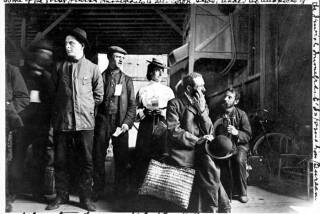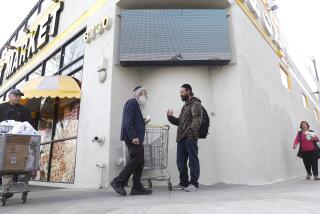AN ETHNIC ERA FADES AWAY IN ‘BORSCHT BELT’
- Share via
Around the turn of the century, Jewish immigrants began to settle in the Catskill Mountains in New York’s Sullivan County, 110 miles northwest of Manhattan. By 1910, 1,200 families had settled there and begun to take in summer boarders in their farmhouses. Eventually, more than a million Jews would flee the city’s sweltering heat to the rapidly growing resort area.
Veteran documentarian Peter Davis’ “The Rise and Fall of the Borscht Belt” (at the Nuart all next week) is an infectious and insightful work of social history comprising reminiscences of the longtime patrons and proprietors of the area’s resort hotels and lodges. It represents a prodigious research effort, for the 80-minute film is chock-full of vintage photographs and home movies dating back to the Borscht Belt’s earliest days. (By the ‘20s, Grossinger’s, the most famous hotel of all, had even produced its own silent promotional movie.) Affectionately narrated by Joseph Wiseman, “The Rise and Fall of the Borscht Belt” is splendid Americana, a microcosm of society at large in which our institutions, businesses and communities tend either to wither or become vast and impersonal in order to survive.
Over the years the farmhouses gave way to bungalow colonies and eventually hotels. The belt weathered the Depression, then enjoyed boom times beginning with World War II when its guests became more prosperous than ever.
But it peaked in the early ‘60s, and today only a handful of the largest hotels thrive amid more than a thousand derelict small inns, which were unable to compete with the top-name entertainment offered by the gigantic Vegas-like establishments. Davis makes clear, however, that more than anything else the Borscht Belt became a victim of assimilation.
From the beginning, entertainment was as popular a staple as the beet soup that gave the region its name and it remains best known to the public at large as a training ground--the borscht circuit--for such entertainers as Eddie Fisher (who married both Debbie Reynolds and Elizabeth Taylor under the fond eye of the late Jennie Grossinger), Sid Caesar (seen clowning in home movies), Danny Kaye, Milton Berle, Steve Lawrence and Eydie Gorme, Jerry Lewis (who was raised in part by that elegant survivor Lillian Brown, of the famous and enduring Brown’s Hotel), Jack Carter, Red Buttons, Dick Shawn and Joey Bishop (who is interviewed all too briefly--the others, perversely, aren’t interviewed at all). Amateur entertainments seem to be pretty much a thing of the past, but a few old-time comedians and “social directors” still hold forth.
The Borscht Belt’s other major role was--and doubtless still is--as a ground for husband-hunting. Davis interviews at length a zaftig matron who recalls with amusement the rituals of her slimmer youth, when a girl had to be careful not to waste her time on any man who wasn’t studying to be a doctor, lawyer or dentist.
Toward the end of “Rise and Fall of the Borscht Belt” (Times-rated Family), Davis concentrates on a gathering of older people at a Sackett Lake resort, people whose children and grandchildren spend their summers elsewhere and who among themselves have formed a kind of extended family to replace their loved ones. They laugh, they clown, and even revive the old custom of the hilariously silly mock wedding. It is entirely a warm, happy occasion, but you view it with sadness, knowing that it represents the end of an era.
More to Read
Sign up for The Wild
We’ll help you find the best places to hike, bike and run, as well as the perfect silent spots for meditation and yoga.
You may occasionally receive promotional content from the Los Angeles Times.






